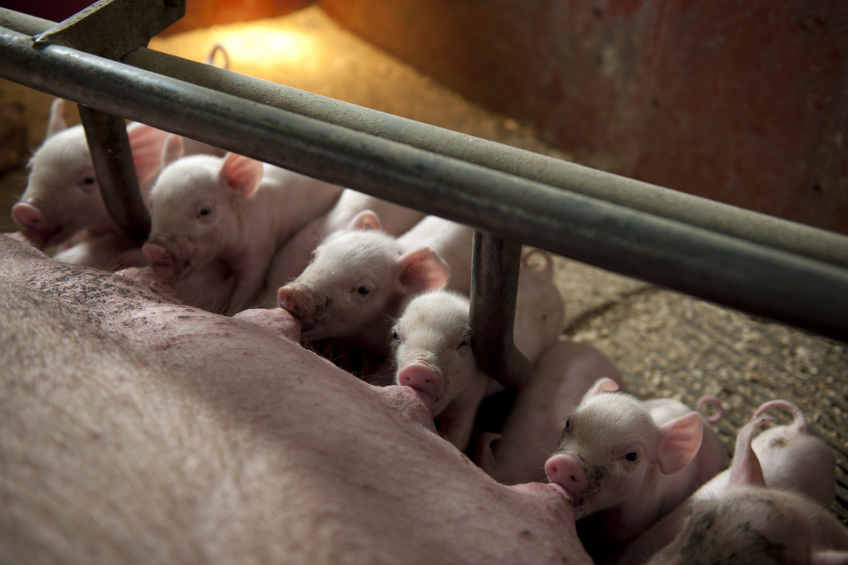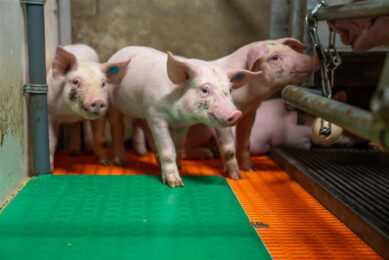Larger litters, smaller piglets, more health problems

Pig litters get increasingly large, which results in smaller, hence weaker, piglets. The timeframe around weaning appears to be when most improvement can be made. Stepping up feed intake can happen through a co-processed soy and yeast product.
By Lars Sangill Andersen and Carsten Pedersen, Hamlet Protein, Denmark
Looking at challenges in pig production from the start of the life cycle, it is easy to spot one area which is currently developing with high speed. As genetics have become more global and production economy has been influencing the goals, one figure in particular sticks out – the number of piglets weaned per sow per year (PSY).
This development is true for most countries having pig production. For example Denmark has shown a PSY increase of six piglets between 2002 and 2012. With the implemented targets for live piglets at day five and the resulting increase in litter size and survival rate this has led to an average of almost 30 PSY in 2012. Looking at statistics and talking to people around the world, it seems that the same trend can be seen everywhere, irrespective of the actual PSY levels.
Piglet size
With litter sizes increasing, the average size of the piglets born decreases. Flemming Thorup, researcher at the Danish Pig Research Centre (VSP) recently showed that each additional piglet in a litter decreases the average piglet birth weight by 40 g. This may not sound a lot, but with an average piglet birth weight being lower than 1.5 kg, this is a significant amount.
Survival rates of smaller piglets may be lower, but both genetics and management skills are improving the survival rate. This does result in smaller piglets going into the nursery.
At the International Pig Veterinary Society (IPVS) congress in Jeju, South Korea, in 2012, Chris Opschoor and others, related to Topigs and the Institute for Pig Genetics, showed a clear relation between weight at birth, weight at weaning, weight at end of rearing and slaughter weight and age, see also Table 1.
Birth weight can only be moderately affected by sow feeding, management or genetics. This leaves us with the fact that piglets at weaning will continue to be smaller as long as litter sizes increase. Having smaller piglets at weaning presents several well-known challenges: Survival rate, feed intake, daily gain, medication consumption and the extra work and eventually the potential reduction in productivity from having an increase in days to slaughter and increased feed conversion for growing-finishing pigs.
Fighting the challenge
The periods immediately pre- and post-weaning offer the most opportunities to fight these challenges. Feeding piglets creep feed usually results in low daily feed intake per pig. Not all the animals in the litter, however, begin eating feed. The creep feed intake the first three weeks after birth is very low or non-existent. Only from week three and onwards a more substantial feed intake can normally be seen. Most pigs throughout the world are weaned between 18 and 28 days of age which does not leave many windows of opportunity for affecting the weaning weight during creep feeding.
Making sure piglets have a high feed intake from weaning (and during creep feeding) is of great importance. Supplying a feed with all the required nutrients and additives to keep the animal healthy and growing, will do little if the feed is not eaten by the piglet. Feed intake impacts development of the intestinal tract by stimulating development of the digestive capacity of the animal. Low or no feed intake for a day or two after weaning will cause the villi of the small intestine to decrease in length and activity. Pigs eating after having had such a fasting period are likely to develop intestinal health problems, either bacterial or nutritional, or both.
Improving feed intake
To improve feed intake it is important to choose feed ingredients that are acceptable to the piglet. A particular sweet flavour alone does not do the trick.
The feed – its ingredients – must have a high digestibility and must not affect the gut adversely. A component in the feed that leads to negative effects in the gut plays a large part in piglet wellbeing and therefore on feed intake.
Looking across the world, the use of blood plasma is often mentioned as a solution for the issues discussed above. Hamlet Protein set out to develop a new alternative to blood plasma. Essentially, the product HP 800 Booster is based on the same technology as the company’s earlier product HP 300, but now the value of yeast and its metabolites is added, by co-processing soy and yeast. Several feeding trials have been performed to verify the effect of this approach.
Three recent feeding trials were conducted at University of Missouri, US, Leuven University, Belgium and University of Warmia and Mazury, Olsztyn, Poland. In all three trials, blood plasma was partly or fully replaced with co-processed soy and yeast. Housing, weaning age, management, other feed ingredients, diet energy level, and standardised ileal amino acid level used in all trials were according to typical local practise and recommendations. Respectively 238, 160 and 1,325 piglets were used; weaning age and weight were, 21, 18 and 28 days and 6.5, 6.5 and 7.4 kg, respectively.
In the US trial, improved feed intake was observed when using co-processed soy and yeast. This resulted in improved ADG (Table 2).
In Belgium, a similar ADG and a significant improved FCR was found (Table 3), whilst in the trial in Poland, a similar performance among treatments was found. In addition, the Polish trial also showed a significant lower variation in piglets live end weight when the co-processed soy and yeast was fed. At the same time there was a significant linear reduction in mortality (a significant decrease between 7.1 and 3.4%; Table 4).
Blood plasma
Typically, blood plasma is fed to improve performance of weaned piglets. The data from the above three studies all show that adding co-processed soy and yeast can be an alternative, without compromising performance. The reduction in mortality observed in the Polish trial showed that the increase in feed intake due to the inclusion of co-processed soy and yeast can impact the survival of pigs. The mortality of light weight piglets at weaning is typically higher than piglets with a high weaning weight. In Poland, the piglets were weighed individually, but not earmarked, so individual piglet performance could not be followed nor the start weight of the piglets that died during the trial period can be summarised. However, it is a reasonable assumption that more piglets with a lower than average birth weight died in Poland, and therefore, ending on the same performance, actually shows an improved performance overall.
When formulating diets with co-processed soy and yeast, the replacement of blood plasma and other ingredients often resulted in a reduction in the overall cost of the total diet.
[Source: Pig Progress Special – Piglet Health, 2014]











